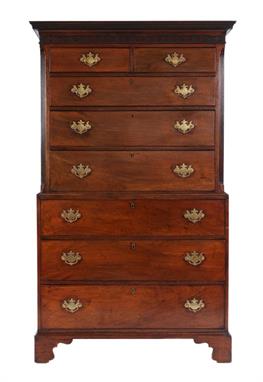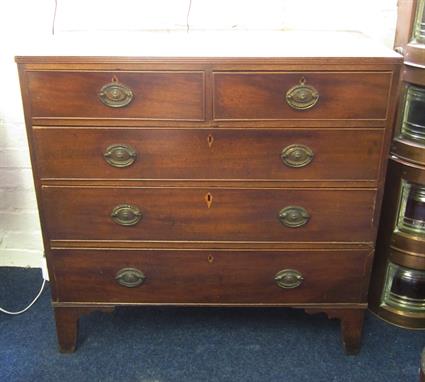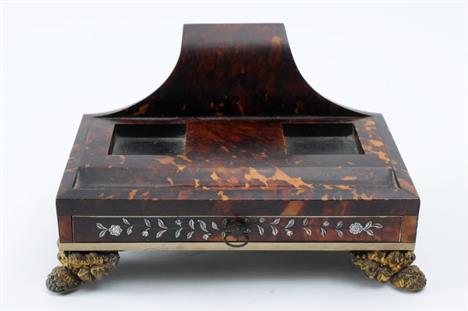177692 Preisdatenbank Los(e) gefunden, die Ihrer Suche entsprechen
177692 Lose gefunden, die zu Ihrer Suche passen. Abonnieren Sie die Preisdatenbank, um sofortigen Zugriff auf alle Dienstleistungen der Preisdatenbank zu haben.
Preisdatenbank abonnieren- Liste
- Galerie
-
177692 Los(e)/Seite
An early 18th Century oak bureau cabinet, the moulded cornice above two doors with ogee arched fielded panels and enclosing an arrangement of pigeon holes and shelves, the sloping flap enclosing a stepped interior with a cupboard and drawers, three short and three long drawers below and on bracket feet, 100cm (3ft 3 1/2in) wide, 200cm (6ft 6 1/2) high. Lacking three interior drawers.
A George III mahogany chest on chest, the upper part with a moulded dentil cornice and blind fret carved frieze, containing two short and three long drawers between fluted canted angles, the lower part containing three long drawers, on bracket feet, 113cm (3ft 8 1/2in) wide, 189cm (6ft 2 1/2in) high.
A late 18th Century cross-banded oak long case clock, the square 12 inch brass dial with silvered chapter ring and subsidiary seconds dial, date aperture, inscribed Aston, Bilson, 30hr movement, the hood with moulded cornice and column supports, the case having long trunk door above a square box base, raised on bracket supports. 204cm high x 30cm wide
An 18th Century mahogany long case clock, the brass dial with Roman and Arabic numerals, subsidiary seconds on a silvered chapter ring, dial and date aperture, eight day movement striking on a bell, indistinctly inscribed ?Evitt, Bath, the arched hood crested by three brass orbs surmounted by eagles, supported by reeded pilasters the case with long shaped trunk door, box base raised on bracket feet, approx. 220cm high x 25cm wide
A George III mahogany banded toilet swing mirror, the oval plate with shaped supports, the bow front base fitted with three drawers with satinwood cross -banding, the central long drawer with ivory escutcheon, flanked by two short drawers, raised on bracket feet. 44cm wide x 22cm deep x 66cm high.
A George III mahogany serpentine front knife box, with boxwood and ebony stringing, the sloping hinged lid decorated with central star patera, opening to reveal fitted compartment interior stringing, part paper label to back, the front with silver escutcheon and shield below, skirted base raised on three bracket feet. 22cm wide x 30cm deep x 39cm high.
John Jackson, Tavistock, a William IV mahogany bracket clock the eight-day duration, double-fusee movement having shaped shoulders and striking the hours on a bell, the eight-inch round convex dial with black Roman numerals, decorative blued steel hands and signed J. Jackson, Tavistock, the dome-topped mahogany case with an inset panel to the front with brass moulding, brass fishscale fretwork to the sides and standing on bun feet, height 43cm. * Biography John Jackson is recorded as working in West Street, Tavistock as a watchmaker and ironmonger from circa 1838 until his death in December 1850 at which time his estate was valued at under 4,000. he previously worked in partnership with one of the Jessop family of Tavistock clockmakers in King Street, circa 1823 and then in West Street from circa 1830, presumably either or both of Thomas and Peter Jessop.
A Victorian Boulle cased chiming bracket clock the eight-day duration, triple-fusee movement striking the hours on a gong and the quarters on eight bells, the break-arch brass dial engraved with floral decoration and with a raised silvered chapter ring engraved with black Roman numerals and decorative half-hour markings, the arch with subsidiary dials for ‘chime/silent, ‘slow/fast’ regulation and ‘Chime on Eight Bells/Cambridge Chimes’, with blued steel fleur-de-lys hands, the tortoiseshell boulle case inlaid with engraved brass with cast-brass floral mounts to the front and sides, with a griffin-head mask to the lower front a male caryatids to the corners, the caddy-top with four flame finials to the lower portion and a further four finials to the top, standing on cast brass feet, height 58cm.
Winterhalder & Hofmeier, Schwarzenbach, a chiming longcase clock the three-train, eight-day duration movement striking the hours on one tube and the quarters on a further four tubes, with brass bound weights and a steel rod pendulum with a brass bob, the eleven-inch brass break-arch dial having a raised chapter ring with raised brass Arabic numerals, with engraved filigree decoration to the dial centre and four corners, with a subsidiary seconds dial, blued steel hands, two subsidiary dials to the top corners for ‘strike/silent’ and ‘chime/silent’ and signed on a silvered cartouche W&H Sch, the mahogany case having a glazed trunk door, short panelled base with further inset panelling to the sides, castellated moulding to the hood with a pediment top, with turned three-quarter columns to the trunk and turned columns to the hood, standing on bracket feet, height 215cm. * Biography Anton Winterhalder, born 1838, founded the business in Schwarzenbach, Germany having married and taking Anton Hofmeier into partnership in 1850, with the company finally closing upon the death of Linus, last son of Winterhalder, in 1930. The movements and clocks made by this firm are often believed to be the among the best produced in Germany at this time.
William Cockey, Yeovil, a mahogany longcase clock the thirty-hour birdcage movement with turned, ringed pillars, striking the hours on a bell with an outside countwheel, the eleven-inch square brass dial having a raised chapter ring engraved with black Roman hour numerals, Arabic five minute numerals and signed either side of VI o’clock Willm. Cockey, Yeovil, with cast brass female-head spandrels to the four corners and a matted dial centre, the oak case having a swan-neck pediment with brass patrae and fluted pillars to the hood with cast brass capitals, with the plain base standing on bracket feet, height 201cm * Biography William Cockey was a member of the well-known Warminster family of clockmakers and bell founders. He both made and maintained clocks for a number of churches in the area including supplying a clock for the tower at Castle Cary Church for which he was paid 8-0-0. In 1736 it is recorded in the records of Montacute Church ‘Mr. Cockey For Righting the Clock and for the Agreement for the Keeping of in Repair for ye Year 1-4-6’. From 1737 until 1761 Cockey was paid 5-0-0 per annum to look after this clock. A number of clocks are recorded by William Cockey including a longcase example in the Dorset Clock Museum at Owermoigne.
John Pitt, Tetbury, an oak longcase clock the eight-day duration movement striking the hours on a bell, the thirteen-inch break-arch painted dial with Arabic hour numerals, floral corner spandrels, a date aperture to the centre, decorative brass hands and signed Jno Pitt, Tetbury, the oak case with fluted canted corners to the trunk, a break-arch trunk door inset with stringing, the hood having square fluted pillars with brass capitals and a swan-neck pediment, standing on bracket feet, height 217cm. *Biography John Pitt is recorded as working in Tetbury, Gloucestershire from the early 19th century. A prolific maker of longcase clocks it is known that he ‘looked after’ the clock at Tetbury Market House from 1816 until 1852 with a payment of 2-2-0 per annum.
A carved oak Victorian chiming longcase clock the eight-day duration movement striking the hours on a tubular gong and the quarters on eight further tubular gongs, with three brass bound weights, the fourteen-inch break-arch brass dial with moonphase aperture to the arch, a raised chapter ring with applied brass Arabic hour numerals, the dial centre engraved with c-scroll decoration and with a subsidiary seconds dial, with cast-brass female-head spandrels to the corners, with two subsidiary dials to the top corners for ‘chime/silent’ and ‘Westminster/Whittington’, with blued steel hands, the oak case with carved decoration, fluted pillars with brass Corinthian capitals to the break-arch hood, with a carved ‘green man’ mask to the centre of the top moulding, with a glazed trunk door, a panelled base and standing on bracket feet, height 250cm.
An 18th Century oak side cupboard, the breakfront upper part with a moulded cornice, enclosed by a pair of moulded fielded panel doors about a central cupboard with enclosing fluted pilaster door, all flanked by brass mounted quarter columns, the lower part containing an arrangement of nine drawers, having fielded panel sides, on bracket feet, 153cm (5ft) wide, 201.5cm (6ft 7 1/4in) high. Provenance. Marianne de Trey.
An 18th Century and later walnut bureau bookcase, the upper part with a moulded cornice, fitted with adjustable shelves enclosed by a pair of glazed panel doors, the lower part with a crossbanded sloping hinged fall bordered with boxwood and ebonised lines enclosing a fitted interior with small drawers and pigeon holes about a central enclosed cupboard, flanked by upright column concealed compartments, the cupboard below enclosed by a pair of fielded panel doors, on bracket feet, 107cm (3ft 6in) wide, 211cm (6ft 11in) high.
-
177692 Los(e)/Seite






















































